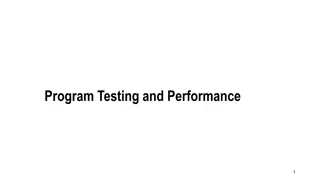Investigating Performance Bottlenecks in Smart Pointer Management
Investigation into performance issues caused by smart pointer manipulation, focusing on the use of boost
Uploaded on Sep 15, 2024 | 1 Views
Download Presentation

Please find below an Image/Link to download the presentation.
The content on the website is provided AS IS for your information and personal use only. It may not be sold, licensed, or shared on other websites without obtaining consent from the author.If you encounter any issues during the download, it is possible that the publisher has removed the file from their server.
You are allowed to download the files provided on this website for personal or commercial use, subject to the condition that they are used lawfully. All files are the property of their respective owners.
The content on the website is provided AS IS for your information and personal use only. It may not be sold, licensed, or shared on other websites without obtaining consent from the author.
E N D
Presentation Transcript
When the not-so-smart manipulation of smart pointers kills performance Fred Suter, Henri Casanova ERROR 2023 3rd Workshop on E-science ReseaRch leading tO negative Results Limassol, Cyprus October 10, 2023 ORNL is managed by UT-Battelle LLC for the US Department of Energy
SimGrid A scientific instrument on your laptop https://simgrid.org Open Project since 1998 2,100+ citations and 500+ usages Key strengths Usability: Fast, Reliable, User-oriented APIs Validated performance models: Predictive Power Versatility: Grid, P2P, HPC, Cloud, Fog, SimGrid s fundamental concepts Actors Execute user-provided functions Program anything you want/need Activities Resources CPUs, Links, Disks Hosts, VMs, Netzones, Computation, communication, I/O Synchro mechanisms Mailboxes Rendez-vous points between actors Fred Suter (suterf@ornl.gov) 2
Observed performance issues Distributed storage for High Energy Physics Complex simulator Developed in Wrench Blamed that simulator Comparison between SimGrid versions For a paper summarizing 10 years of dev v3.10 (11/2013) vs. v3.34 (06/2023) Simple Coordinator-Worker scheme Cannot blame anyone else!!! v3.34 scales very poorly Fred Suter (suterf@ornl.gov) 3
The investigation begins! 1. Determine which functions are the performance bottlenecks Refcount management of smart pointers Matching of simulated communications Version 3.10 3.14 3.15 3.16 3.20 3.34 Simulation time 2. Determine which release introduced the performance loss Build docker of releases since 3.10* Identify 3.16 as the problem (06/2017) 51.42s 28.39s 29.07s 203.45s 160.78s 158.23 (*) https://github.com/henricasanova/master_worker_flashback Fred Suter (suterf@ornl.gov) 4
Analyzing the sources Smart pointers v3.16 introduces the use of boost::intrusive_ptr Store a pointer to an object with an embedded reference count New instance increments the refcount, when refcount becomes 0, object is destroyed Used for almost all simulated objects In particular for the kernel implementation of Activities (Computation, Communication, I/O) Matching simulated comms Only 2-sided activity: sender and receiver using a common mailbox Each creates a distinct Comm object and tries to find a match in the mailbox Each mailbox stores pending and unmatched comms in a queue Once matched, one of the two Comm objects is deleted Fred Suter (suterf@ornl.gov) 5
Here comes the not-so-smart choice! Data structure to store pending/unmatched Comms Potentially large number of objects to store Many communications Asynchronous communications Let s use a fancy optimized data structure boost::circular_buffer_space_optimized seems smart!! But there is a catch When we remove a matched comm It can be at any position Elements are shifted to keep them contiguous And moving smart pointers messes with their refcount Again and again!!! Let s use a not-smart std::list, duh! (it s a 2-line fix) Fred Suter (suterf@ornl.gov) 6
Impact of changing the underlying data structure Fred Suter (suterf@ornl.gov) 7
Takeaway messages Mixing advanced objects and data structures Advantages can be clear and choices well motivated For each object/data structure individually But the interplay of these choices has to be carefully thought At least more than we did in this particular case! Importance of performance regression testing CI/CD is good to detect introduction of bugs Measuring impact on performance is more difficult And can be overlooked Fred Suter (suterf@ornl.gov) 8























